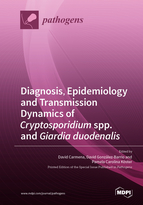Diagnosis, Epidemiology and Transmission Dynamics of Cryptosporidium spp. and Giardia duodenalis
A special issue of Pathogens (ISSN 2076-0817). This special issue belongs to the section "Parasitic Pathogens".
Deadline for manuscript submissions: closed (30 September 2021) | Viewed by 38310
Special Issue Editors
Interests: zoonotic diseases; protist; helminth; cryptosporidium; giardia; blastocystis; enterocytozoon; echinococcus; diagnosis, molecular epidemiology; transmission dynamics; evaluation socioeconomic impact
Special Issues, Collections and Topics in MDPI journals
Interests: David´s research is mainly focused on shared emerging diseases between domestic animals, wildlife, and humans, with a special interest in diagnostics, epidemiology, and molecular epidemiology in their main wildlife reservoirs.
Special Issues, Collections and Topics in MDPI journals
Interests: Pamela's research is mainly focused on the detection and molecular characterization of diarrhoea-causing enteric protists in wildlife, with a special interest in endangered non-human primate species. Her research includes the identification and characterization of zoonotic transmission events and how anthropic activities influence the health status of free-living animal communities.
Special Issue Information
Dear Colleagues,
The enteric protozoans Cryptosporidium spp. and Giardia duodenalis are the most common diarrhoea-causing protozoan parasites worldwide. Cryptosporidium spp. is a leading cause of diarrhoea morbidity and mortality in children younger than 5 years in poor-resource settings in sub-Saharan Africa and South Asia. Although infection by G. duodenalis is rarely a fatal condition, giardiasis is commonly associated with childhood growth faltering and cognitive impairment. Because of their significant socioeconomic impact, particularly in low-income countries, giardiasis and cryptosporidiosis joined the “Neglected Disease Initiative” launched by the World Health Organization in 2004. Both Cryptosporidium spp. and G. duodenalis are ubiquitous in the environment and can infect a wide range of hosts with different specificities, meaning that humans may acquire the infection via waterborne, foodborne, or zoonotic transmission.
Recent advances in detection and molecular epidemiology have indicated that certain species/genotypes of Cryptosporidium and G. duodenalis have an expanded range of suitable hosts, suggesting that their transmission pathways are more intricate than previously thought, challenging our current notion of host specificities. Therefore, there is a clear need for more studies aiming at investigating the frequency and molecular diversity of these parasites in humans, production and companion animals, and wildlife species. This information would be extremely useful to elucidate the transmission dynamics of cryptosporidiosis and giardiasis, and to investigate the exact contribution of zoonotic events to human infections.
For this Special Issue, we invite you to send contributions on any aspects that may help to clarify the detection, epidemiology, genetic diversity, and transmission dynamics of Cryptosporidium spp. and G. duodenalis from a public veterinary health perspective. Under the One Health umbrella, environmental studies investigating the occurrence and molecular diversity of these pathogens in surface water and food matrices are also welcome.
Dr. David Carmena
Dr. David González-Barrio
Ms. Pamela Carolina Köster
Guest Editors
Manuscript Submission Information
Manuscripts should be submitted online at www.mdpi.com by registering and logging in to this website. Once you are registered, click here to go to the submission form. Manuscripts can be submitted until the deadline. All submissions that pass pre-check are peer-reviewed. Accepted papers will be published continuously in the journal (as soon as accepted) and will be listed together on the special issue website. Research articles, review articles as well as short communications are invited. For planned papers, a title and short abstract (about 100 words) can be sent to the Editorial Office for announcement on this website.
Submitted manuscripts should not have been published previously, nor be under consideration for publication elsewhere (except conference proceedings papers). All manuscripts are thoroughly refereed through a single-blind peer-review process. A guide for authors and other relevant information for submission of manuscripts is available on the Instructions for Authors page. Pathogens is an international peer-reviewed open access monthly journal published by MDPI.
Please visit the Instructions for Authors page before submitting a manuscript. The Article Processing Charge (APC) for publication in this open access journal is 2700 CHF (Swiss Francs). Submitted papers should be well formatted and use good English. Authors may use MDPI's English editing service prior to publication or during author revisions.
Keywords
- Cryptosporidium
- Giardia
- epidemiology
- transmission
- zoonoses
- detection
- genotyping









